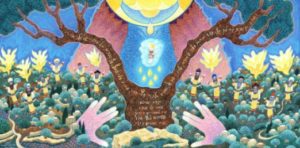Parshat Vayigash 2021
By Rabbi Moshe Goodman, Kollel Ohr Shlomo, Hebron
בס”ד
לשכנו תדרשו
Discover the Holy Presence in Our Holy Land
And They Shall Be One Tree

In this painting we see two trees united as the Haftora of this week’s parsha hints to, albeit by staffs. It seems that Nachshon wanted to give this image of unity an organic essence as if they are one tree in essence as the Haftorah states [as written explicitly within the tree in the painting] “and they shall be one tree.”Also, Nachshon may have wished that this unity take on a living/vegetative reality that grows with time in the image of two trunks of trees united. In the background we see twelve dancing hasidim obviously hinting at the twelve tribes united in this painting’s theme of unity. It should be noted that there are six hasidim to the right of the tree and six hasidim to the left of the tree, and also there are six branches on the right side of the tree and six branches, and that all the branches come as pairs. This matter seems to reflect the Kabbalistic teaching that each of the tribes is linked to one of the twelve months of the year. The Arizal taught that there are six winter months that parallel the six summer months. In addition, Kabbalisitically there is a “pairing” of these “six-groups” into three pairs so that Yehuda is paired with Reuven, Yissachar with Shimon, etc. We see the hands of the Kohen outstretched and split as is customary when saying the Kohannic benediction which is juxtaposed to the blessing for peace in the Amida – peace is key for unity, the theme of this painting. We also see seven drops of oil, seemingly hinting to the Messiah, which means “the one anointed by oil,” and who will unite Israel together in the service of Hashem. We see that the seventh drop, a number associated Kabbalistically with the theme of Malchut-Kingship and King Messiah, is just above the face of the Lubavitcher Rebbe, as it is well-known that the Lubavitcher Rebbe was very much involved with Messianism and bringing the Redemption, especially through unity, the primary theme of this painting. We also see that the seven angels and the twelve hasidim are colored in the same color as the oil, signifying that the unity of the tribes and spiritual elevation as signified by the angels are an integral part of the Messianic Redemption. Also, notice that each angel is tripled, apparently signifying Ezekiel’s vision: “with two they shall cover their face, with two they shall cover their legs, and with two they shall fly.”
All of these messages are primary themes of Hebron, where Nachshon lived, painted, and received his inspiration. This is Hebron, the City of Unity-Hibur, the City where the angels appeared to Avraham, the City of Redemption “At that time (the end of days), the three Patriarchs will adjoin with might, and teruah, shevarim, and tekiah will be sounded, and with them the “the earth will shake,” and this will be in the “end of days,” and all these miracles will be in the Land of Israel, for there is located Hebron where the Patriarchs are buried” (Tikunei Zohar 13:28b).